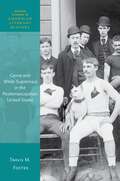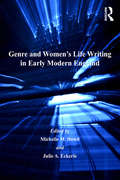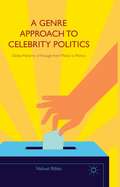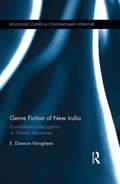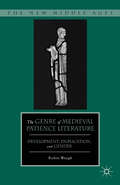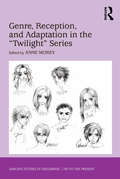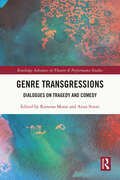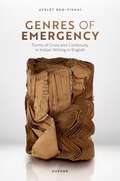- Table View
- List View
Genre and Reception in the Gothic Parody: Framing the Subversive Heroine (Routledge Studies in Speculative Fiction)
by Kerstin-Anja MünderleinThis book brings together an analysis of the theoretical connection of genre, reception, and frame theory and a practical demonstration thereof, using a set of parodies of the first wave of the Gothic novel, ranging from well-known titles such as Jane Austen’s Northanger Abbey, to little known and researched titles such as Mary Charlton’s Rosella. Münderlein traces the development of socio-political debates conducted in the late eighteenth and early nineteenth centuries on female roles, behaviour, and subversion from the subtly subversive Gothic novel to the Gothic parody. Combining two major areas of research, literary criticism and Gothic studies, the book provides both a new take on an ongoing debate in literary criticism as well as an in-depth study of a virtually neglected aspect of Gothic studies, the Gothic parody.
Genre and White Supremacy in the Postemancipation United States (Oxford Studies in American Literary History)
by Travis M. FosterHow are we to comprehend, diagnose, and counter a system of racist subjugation so ordinary it has become utterly asymptomatic? Challenging the prevailing literary critical inclination toward what makes texts exceptional or distinctive, Genre and White Supremacy in the Postemancipation United States underscores the urgent importance of genre for tracking conventionality as it enters into, constitutes, and reproduces ordinary life. In the wake of emancipation's failed promise, two developments unfolded: white supremacy amassed new mechanisms and procedures for reproducing racial hierarchy; and black freedom developed new practices for collective expression and experimentation. This new racial ordinary came into being through new literary and cultural genres—including campus novels, the Ladies' Home Journal, Civil War elegies, and gospel sermons. Through the postemancipation interplay between aesthetic conventions and social norms, genre became a major influence in how Americans understood their social and political affiliations, their citizenship, and their race. Travis M. Foster traces this thick history through four decades following the Civil War, equipping us to understand ordinary practices of resistance more fully and to resist ordinary procedures of subjugation more effectively. In the process, he provides a model for how the study of popular genre can reinvigorate our methods for historicizing the everyday.
Genre and White Supremacy in the Postemancipation United States (Oxford Studies in American Literary History)
by Travis M. FosterHow are we to comprehend, diagnose, and counter a system of racist subjugation so ordinary it has become utterly asymptomatic? Challenging the prevailing literary critical inclination toward what makes texts exceptional or distinctive, Genre and White Supremacy in the Postemancipation United States underscores the urgent importance of genre for tracking conventionality as it enters into, constitutes, and reproduces ordinary life. In the wake of emancipation's failed promise, two developments unfolded: white supremacy amassed new mechanisms and procedures for reproducing racial hierarchy; and black freedom developed new practices for collective expression and experimentation. This new racial ordinary came into being through new literary and cultural genres—including campus novels, the Ladies' Home Journal, Civil War elegies, and gospel sermons. Through the postemancipation interplay between aesthetic conventions and social norms, genre became a major influence in how Americans understood their social and political affiliations, their citizenship, and their race. Travis M. Foster traces this thick history through four decades following the Civil War, equipping us to understand ordinary practices of resistance more fully and to resist ordinary procedures of subjugation more effectively. In the process, he provides a model for how the study of popular genre can reinvigorate our methods for historicizing the everyday.
Genre and Women's Life Writing in Early Modern England
by Michelle M. DowdBy taking account of the ways in which early modern women made use of formal and generic structures to constitute themselves in writing, the essays collected here interrogate the discursive contours of gendered identity in sixteenth- and seventeenth-century England. The contributors explore how generic choice, mixture, and revision influence narrative constructions of the female self in early modern England. Collectively they situate women's life writings within the broader textual culture of early modern England while maintaining a focus on the particular rhetorical devices and narrative structures that comprise individual texts. Reconsidering women's life writing in light of recent critical trends-most notably historical formalism-this volume produces both new readings of early modern texts (such as Margaret Cavendish's autobiography and the diary of Anne Clifford) and a new understanding of the complex relationships between literary forms and early modern women's 'selves'. This volume engages with new critical methods to make innovative connections between canonical and non-canonical writing; in so doing, it helps to shape the future of scholarship on early modern women.
Genre and Women's Life Writing in Early Modern England
by Michelle M. Dowd Julie A. EckerleBy taking account of the ways in which early modern women made use of formal and generic structures to constitute themselves in writing, the essays collected here interrogate the discursive contours of gendered identity in sixteenth- and seventeenth-century England. The contributors explore how generic choice, mixture, and revision influence narrative constructions of the female self in early modern England. Collectively they situate women's life writings within the broader textual culture of early modern England while maintaining a focus on the particular rhetorical devices and narrative structures that comprise individual texts. Reconsidering women's life writing in light of recent critical trends-most notably historical formalism-this volume produces both new readings of early modern texts (such as Margaret Cavendish's autobiography and the diary of Anne Clifford) and a new understanding of the complex relationships between literary forms and early modern women's 'selves'. This volume engages with new critical methods to make innovative connections between canonical and non-canonical writing; in so doing, it helps to shape the future of scholarship on early modern women.
A Genre Approach to Celebrity Politics: Global Patterns of Passage from Media to Politics
by Nahuel RibkeExploring the transition of celebrities into institutional-electoral politics, the book argues that many insights developed by genre theorists could be highly instrumental to understand the celebrity politics phenomenon. It analyzes the historical and cultural specificity of celebrity politics as it evolved through different countries and cultures.
Genre, Authorship and Contemporary Women Filmmakers (PDF)
by Katarzyna PaszkiewiczGenre, Authorship and Contemporary Women Filmmakers' examines the significance of women's contribution to genre cinema by highlighting the work of US filmmakers within and outside Hollywood - Kathryn Bigelow, Sofia Coppola, Nancy Meyers and Kelly Reichardt, among others. Exploring genres as diverse as horror, the war movie, the Western, the costume biopic and the romantic comedy, Katarzyna Paszkiewicz interrogates questions of 'genre' authorship; the blurring of the borders between commercial and independent cinema and gendered discourses of (de)authorisation that operate within each sphere; 'male' - 'female' genre divisions; and the issue of authorial subversion in film and popular culture in a wider sense. With its focus on close analysis of the films themselves and the cultural and ideological meanings involved in the reception of genre texts authored by women, this book expands critical debates around women's cinema and offers new perspectives on how contemporary filmmakers explore the aesthetic and imaginative power of genre.
Genre Fiction of New India: Post-millennial receptions of "weird" narratives (Routledge Studies in Contemporary Literature)
by E. Dawson VarugheseThis book investigates fiction in English, written within, and published from India since 2000 in the genre of mythology-inspired fiction in doing so it introduces the term ‘Bharati Fantasy’. This volume is anchored in notions of the ‘weird’ and thus some time is spent understanding this term linguistically, historically (‘wyrd’) as well as philosophically and most significantly socio-culturally because ‘reception’ is a key theme to this book’s thesis. The book studies the interface of science, Hinduism and itihasa (a term often translated as ‘history’) within mythology-inspired fiction in English from India and these are specifically examined through the lens of two overarching interests: reader reception and the genre of weird fiction. The book considers Indian and non-Indian receptions to the body of mythology-inspired fiction, highlighting how English fiction from India has moved away from being identified as the traditional Indian postcolonial text. Furthermore, the book reveals broader findings in relation to identity and Indianness and India’s post-millennial society’s interest in portraying and projecting ideas of India through its ancient cultures, epic narratives and cultural (Hindu) figures.
Genre Fiction of New India: Post-millennial receptions of "weird" narratives (Routledge Studies in Contemporary Literature)
by E. Dawson VarugheseThis book investigates fiction in English, written within, and published from India since 2000 in the genre of mythology-inspired fiction in doing so it introduces the term ‘Bharati Fantasy’. This volume is anchored in notions of the ‘weird’ and thus some time is spent understanding this term linguistically, historically (‘wyrd’) as well as philosophically and most significantly socio-culturally because ‘reception’ is a key theme to this book’s thesis. The book studies the interface of science, Hinduism and itihasa (a term often translated as ‘history’) within mythology-inspired fiction in English from India and these are specifically examined through the lens of two overarching interests: reader reception and the genre of weird fiction. The book considers Indian and non-Indian receptions to the body of mythology-inspired fiction, highlighting how English fiction from India has moved away from being identified as the traditional Indian postcolonial text. Furthermore, the book reveals broader findings in relation to identity and Indianness and India’s post-millennial society’s interest in portraying and projecting ideas of India through its ancient cultures, epic narratives and cultural (Hindu) figures.
The Genre of Medieval Patience Literature: Development, Duplication, and Gender (The New Middle Ages)
by R. WaughThis book examines evolution of medieval patience literature from a focus on male and female sufferers to a focus on female suffers in particular. Using feminist revisions of genre-theory, Waugh analyses the concept of counterfeit consciousness in the works of Margery Kempe and Chaucer among others.
Genre, Reception, and Adaptation in the 'Twilight' Series (Studies in Childhood, 1700 to the Present)
by Anne MoreyMuch of the criticism on Stephenie Meyer's immensely popular 'Twilight' novels has underrated or even disparaged the books while belittling the questionable taste of an audience that many believe is being inculcated with anti-feminist values. Avoiding a repetition of such reductive critiques of the series's purported shortcomings with respect to literary merit and political correctness, this volume adopts a cultural studies framework to explore the range of scholarly concerns awakened by the 'Twilight novels and their filmic adaptations. Contributors examine 'Twilight's debts to its predecessors in young adult, vampire, and romance literature; the problems of cinematic adaptation; issues in fan and critical reception in the United States and Korea; and the relationship between the series and contemporary conceptualizations of feminism, particularly girl culture. Placing the series within a broad tradition of literary history, reception studies, and filmic adaptation, the collection offers scholars the opportunity to engage with the books' importance for studies of popular culture, gender, and young adult literature.
Genre, Reception, and Adaptation in the 'Twilight' Series (Studies in Childhood, 1700 to the Present)
by Anne MoreyMuch of the criticism on Stephenie Meyer's immensely popular 'Twilight' novels has underrated or even disparaged the books while belittling the questionable taste of an audience that many believe is being inculcated with anti-feminist values. Avoiding a repetition of such reductive critiques of the series's purported shortcomings with respect to literary merit and political correctness, this volume adopts a cultural studies framework to explore the range of scholarly concerns awakened by the 'Twilight novels and their filmic adaptations. Contributors examine 'Twilight's debts to its predecessors in young adult, vampire, and romance literature; the problems of cinematic adaptation; issues in fan and critical reception in the United States and Korea; and the relationship between the series and contemporary conceptualizations of feminism, particularly girl culture. Placing the series within a broad tradition of literary history, reception studies, and filmic adaptation, the collection offers scholars the opportunity to engage with the books' importance for studies of popular culture, gender, and young adult literature.
Genre, ship and Contemporary Women Filmmakers
by Katarzyna PaszkiewiczExplores the interaction between science, literature and spectacle in Shakespeare’s era
Genre Transgressions: Dialogues on Tragedy and Comedy (ISSN)
by Ramona Mosse Anna StreetThis collection gathers a set of provocative essays that sketch innovative and interdisciplinary approaches to Genre Theory in the 21st century. Focusing on the interaction between tragedy and comedy, both renowned and emerging scholarly and creative voices from philosophy, theater, literature, and cultural studies come together to engage in dialogues that reconfigure genre as social, communal, and affective.In revisiting the challenges to aesthetic categorization over the course of the 20th century, this volume proposes a shift away from the prescriptive and hierarchical reading of genre to its crucial function in shaping thought and enabling shared experience and communication. In doing so, the various essays acknowledge the diverse contexts within which genre needs to be thought afresh: media studies, rhetoric, politics, performance, and philosophy.
Genre Transgressions: Dialogues on Tragedy and Comedy (ISSN)
by Ramona Mosse Anna StreetThis collection gathers a set of provocative essays that sketch innovative and interdisciplinary approaches to Genre Theory in the 21st century. Focusing on the interaction between tragedy and comedy, both renowned and emerging scholarly and creative voices from philosophy, theater, literature, and cultural studies come together to engage in dialogues that reconfigure genre as social, communal, and affective.In revisiting the challenges to aesthetic categorization over the course of the 20th century, this volume proposes a shift away from the prescriptive and hierarchical reading of genre to its crucial function in shaping thought and enabling shared experience and communication. In doing so, the various essays acknowledge the diverse contexts within which genre needs to be thought afresh: media studies, rhetoric, politics, performance, and philosophy.
Genres and Provenance in the Comedy of W.S. Gilbert: Pipes and Tabors (Routledge Studies in Nineteenth Century Literature #2)
by Richard MooreIn The Progress of Fun W.S. Gilbert was considered, not as a ‘classic Victorian’, but as part of an on-going comedic continuum stretching from Aristophanes to Joe Orton and beyond. Pipes and Tabors continues the story, covering the comedic experience differently by reference to genres. Here – treated in relation to a line of significant others – we discover how Gilbert responded to areas such as the Pastoral, the Irish drama, nautical scenarios, melodrama, sensation-theatre, the nonsensemode, pantomime spectaculars, fairy plays, and classical farce. Also included is a wider look at his relation to various European musical forms and (for instance) to the English line of wit and the Elizabethan pamphleteers. To consider a writer not so much by a study of individual works as by threads of linking generic modes tells us a great deal about cultural interconnections and the richly textured nature of theatrical experience. Pipes and Tabors offers a tapestry of overlapping genres and treatments, showing not just the design of the finished products but the shreds and patches which form the underside of the weave. According to Dorothy L. Sayers, life itself offers us the apparent loose ends of a design which will only be revealed from the front after death. In terms of Gilbertian comedy, we are privileged to be able to track both the effort of the weave and the skill of the finished product. On the way we will also discover some new links and sub-text implications about other 19th century denigrated groups which were buried from sight for too long.
Genres and Provenance in the Comedy of W.S. Gilbert: Pipes and Tabors (Routledge Studies in Nineteenth Century Literature #2)
by Richard MooreIn The Progress of Fun W.S. Gilbert was considered, not as a ‘classic Victorian’, but as part of an on-going comedic continuum stretching from Aristophanes to Joe Orton and beyond. Pipes and Tabors continues the story, covering the comedic experience differently by reference to genres. Here – treated in relation to a line of significant others – we discover how Gilbert responded to areas such as the Pastoral, the Irish drama, nautical scenarios, melodrama, sensation-theatre, the nonsensemode, pantomime spectaculars, fairy plays, and classical farce. Also included is a wider look at his relation to various European musical forms and (for instance) to the English line of wit and the Elizabethan pamphleteers. To consider a writer not so much by a study of individual works as by threads of linking generic modes tells us a great deal about cultural interconnections and the richly textured nature of theatrical experience. Pipes and Tabors offers a tapestry of overlapping genres and treatments, showing not just the design of the finished products but the shreds and patches which form the underside of the weave. According to Dorothy L. Sayers, life itself offers us the apparent loose ends of a design which will only be revealed from the front after death. In terms of Gilbertian comedy, we are privileged to be able to track both the effort of the weave and the skill of the finished product. On the way we will also discover some new links and sub-text implications about other 19th century denigrated groups which were buried from sight for too long.
Genres of Emergency: Forms of Crisis and Continuity in Indian Writing in English
by Ayelet Ben-YishaiGenres of Emergency offers literary genre as a way to understand and negotiate the varied states of emergency and crisis that have become a fixture of our contemporary world. Building on a critical study of the literature written during and about the State of Emergency declared by Prime Minister Indira Gandhi in India (1975 - 1977), the study establishes emergency and its genres as an important interpretative site: an exceptionally violent episode marked as a one-off crisis, which also functions as a locus for an ongoing renegotiation of a modern polity and culture. Reading a wide-ranging archive of English-language texts - from prison memoir to popular magazine, from high-brow literary fiction to boilerplate thriller, from the unrelentingly realistic to the mythically allegorical - Genres of Emergency traces the tension between crisis and continuity that these genres mediate. In addressing this tension, the authors of Emergency fiction take seriously the genres in which they write and use them to mobilize literary conventions as political interventions. More specifically, these novels use the conventions of realism, epic, allegory, and the thriller to reach back in time and across cultures and languages, invoking past iterations of these genres and histories and anticipating those to come. Combining literary criticism with cultural history, Genres of Emergency thus has implications for the study of literary genre, for the historical events that these genres recount, and for understanding the politics of literary form.
Genres of Emergency: Forms of Crisis and Continuity in Indian Writing in English
by Ayelet Ben-YishaiGenres of Emergency offers literary genre as a way to understand and negotiate the varied states of emergency and crisis that have become a fixture of our contemporary world. Building on a critical study of the literature written during and about the State of Emergency declared by Prime Minister Indira Gandhi in India (1975 - 1977), the study establishes emergency and its genres as an important interpretative site: an exceptionally violent episode marked as a one-off crisis, which also functions as a locus for an ongoing renegotiation of a modern polity and culture. Reading a wide-ranging archive of English-language texts - from prison memoir to popular magazine, from high-brow literary fiction to boilerplate thriller, from the unrelentingly realistic to the mythically allegorical - Genres of Emergency traces the tension between crisis and continuity that these genres mediate. In addressing this tension, the authors of Emergency fiction take seriously the genres in which they write and use them to mobilize literary conventions as political interventions. More specifically, these novels use the conventions of realism, epic, allegory, and the thriller to reach back in time and across cultures and languages, invoking past iterations of these genres and histories and anticipating those to come. Combining literary criticism with cultural history, Genres of Emergency thus has implications for the study of literary genre, for the historical events that these genres recount, and for understanding the politics of literary form.
Genres of Privacy in Postwar America (Post*45)
by Palmer RampellWith this incisive work, Palmer Rampell reveals the surprising role genre fiction played in redefining the category of the private person in the postwar period. Especially after the Supreme Court established a constitutional right to privacy in 1965, legal scholars, judges, and the public scrambled to understand the scope of that right. Before and after the Court's ruling, authors of genre fiction and film reformulated their aliens, androids, and monsters to engage in debates about personal privacy as it pertained to issues like abortion, police surveillance, and euthanasia. Triangulating novels and films with original archival discoveries and historical and legal research, Rampell provides new readings of Patricia Highsmith, Dorothy B. Hughes, Philip K. Dick, Octavia Butler, Chester Himes, Stephen King, Cormac McCarthy, and others. The book pairs the right of privacy for heterosexual sex with queer and proto-feminist crime fiction; racialized police surveillance at midcentury with Black crime fiction; Roe v. Wade (1973) with 1960s and 1970s science fiction; the Child Abuse Prevention and Treatment Act (1974) with horror; and the right to die with westerns. While we are accustomed to defenses of fiction for its capacity to represent fully rendered private life, Rampell suggests that we might value a certain strand of genre fiction for its capacity to theorize the meaning of the protean concept of privacy.
Genres of Privacy in Postwar America (Post*45)
by Palmer RampellWith this incisive work, Palmer Rampell reveals the surprising role genre fiction played in redefining the category of the private person in the postwar period. Especially after the Supreme Court established a constitutional right to privacy in 1965, legal scholars, judges, and the public scrambled to understand the scope of that right. Before and after the Court's ruling, authors of genre fiction and film reformulated their aliens, androids, and monsters to engage in debates about personal privacy as it pertained to issues like abortion, police surveillance, and euthanasia. Triangulating novels and films with original archival discoveries and historical and legal research, Rampell provides new readings of Patricia Highsmith, Dorothy B. Hughes, Philip K. Dick, Octavia Butler, Chester Himes, Stephen King, Cormac McCarthy, and others. The book pairs the right of privacy for heterosexual sex with queer and proto-feminist crime fiction; racialized police surveillance at midcentury with Black crime fiction; Roe v. Wade (1973) with 1960s and 1970s science fiction; the Child Abuse Prevention and Treatment Act (1974) with horror; and the right to die with westerns. While we are accustomed to defenses of fiction for its capacity to represent fully rendered private life, Rampell suggests that we might value a certain strand of genre fiction for its capacity to theorize the meaning of the protean concept of privacy.
The genres of Renaissance tragedy
by Lisa Hopkins Daniel Cadman Andrew DuxfieldThis collection of newly commissioned essays explores the extraordinary versatility of Renaissance tragedy and shows how it enables exploration of issues ranging from gender to race to religious conflict, as well as providing us with some of the earliest dramatic representations of the lives of ordinary Englishmen and women. The book mixes perspectives from emerging scholars with those of established ones and offers the first systematic examination of the full range and versatility of Renaissance tragedy as a literary genre. It works by case study, so that each chapter offers not only a definition of a particular kind of Renaissance tragedy but also new research into a particularly noteworthy or influential example of that genre. Collectively the essays examine the work of a range of dramatists and offer a critical overview of Renaissance tragedy as a genre.
The genres of Renaissance tragedy
by Lisa Hopkins Daniel Cadman Andrew DuxfieldThis collection of newly commissioned essays explores the extraordinary versatility of Renaissance tragedy and shows how it enables exploration of issues ranging from gender to race to religious conflict, as well as providing us with some of the earliest dramatic representations of the lives of ordinary Englishmen and women. The book mixes perspectives from emerging scholars with those of established ones and offers the first systematic examination of the full range and versatility of Renaissance tragedy as a literary genre. It works by case study, so that each chapter offers not only a definition of a particular kind of Renaissance tragedy but also new research into a particularly noteworthy or influential example of that genre. Collectively the essays examine the work of a range of dramatists and offer a critical overview of Renaissance tragedy as a genre.
Genres of the Credit Economy: Mediating Value in Eighteenth- and Nineteenth-Century Britain
by Mary PooveyHow did banking, borrowing, investing, and even losing money—in other words, participating in the modern financial system—come to seem likeroutine activities of everydaylife? Genres of the Credit Economy addressesthis question by examining the history of financial instruments and representations of finance in eighteenth- and nineteenth-century Britain. Chronicling the process by which some of our most important conceptual categories were naturalized, Mary Poovey explores complex relationships among forms of writing that are not usually viewed together, from bills of exchange and bank checks, to realist novels and Romantic poems, to economic theory and financial journalism. Taking up all early forms of financial and monetarywriting, Poovey argues that these genres mediated for early modern Britons the operations of a market system organized around credit and debt. By arguing that genre is a critical tool for historical and theoretical analysis and an agent in the events that formed the modern world, Poovey offers a new way to appreciate the character of the credit economy and demonstrates the contribution historians and literary scholars can make to understanding its operations. Much more than an exploration of writing on and around money, Genres of the Credit Economy offers startling insights about the evolution of disciplines and the separation of factual and fictional genres.
Genres of the Credit Economy: Mediating Value in Eighteenth- and Nineteenth-Century Britain
by Mary PooveyHow did banking, borrowing, investing, and even losing money—in other words, participating in the modern financial system—come to seem likeroutine activities of everydaylife? Genres of the Credit Economy addressesthis question by examining the history of financial instruments and representations of finance in eighteenth- and nineteenth-century Britain. Chronicling the process by which some of our most important conceptual categories were naturalized, Mary Poovey explores complex relationships among forms of writing that are not usually viewed together, from bills of exchange and bank checks, to realist novels and Romantic poems, to economic theory and financial journalism. Taking up all early forms of financial and monetarywriting, Poovey argues that these genres mediated for early modern Britons the operations of a market system organized around credit and debt. By arguing that genre is a critical tool for historical and theoretical analysis and an agent in the events that formed the modern world, Poovey offers a new way to appreciate the character of the credit economy and demonstrates the contribution historians and literary scholars can make to understanding its operations. Much more than an exploration of writing on and around money, Genres of the Credit Economy offers startling insights about the evolution of disciplines and the separation of factual and fictional genres.

